Evaluating Project Scope Change Impact at Omantel: Methodology
VerifiedAdded on 2019/10/30
|20
|4325
|475
Report
AI Summary
This report outlines the research methodology employed to evaluate the impact of project scope changes on project objectives within Omantel Company. The study utilizes a positivism philosophy and a deductive approach, employing a descriptive research design. Data collection involves both primary and secondary methods, including surveys with senior-level employees and interviews with project managers. The research instruments include closed-ended questionnaires for the survey and open-ended questions for the interviews. The population of the study comprises employees and project managers at Omantel. The researcher used a simple random sampling technique and a sample size of 35 senior employees for the survey. The report details the data analysis techniques and discusses legal, social, and ethical considerations. The research aims to provide a comprehensive understanding of how scope changes affect project outcomes within the organization.
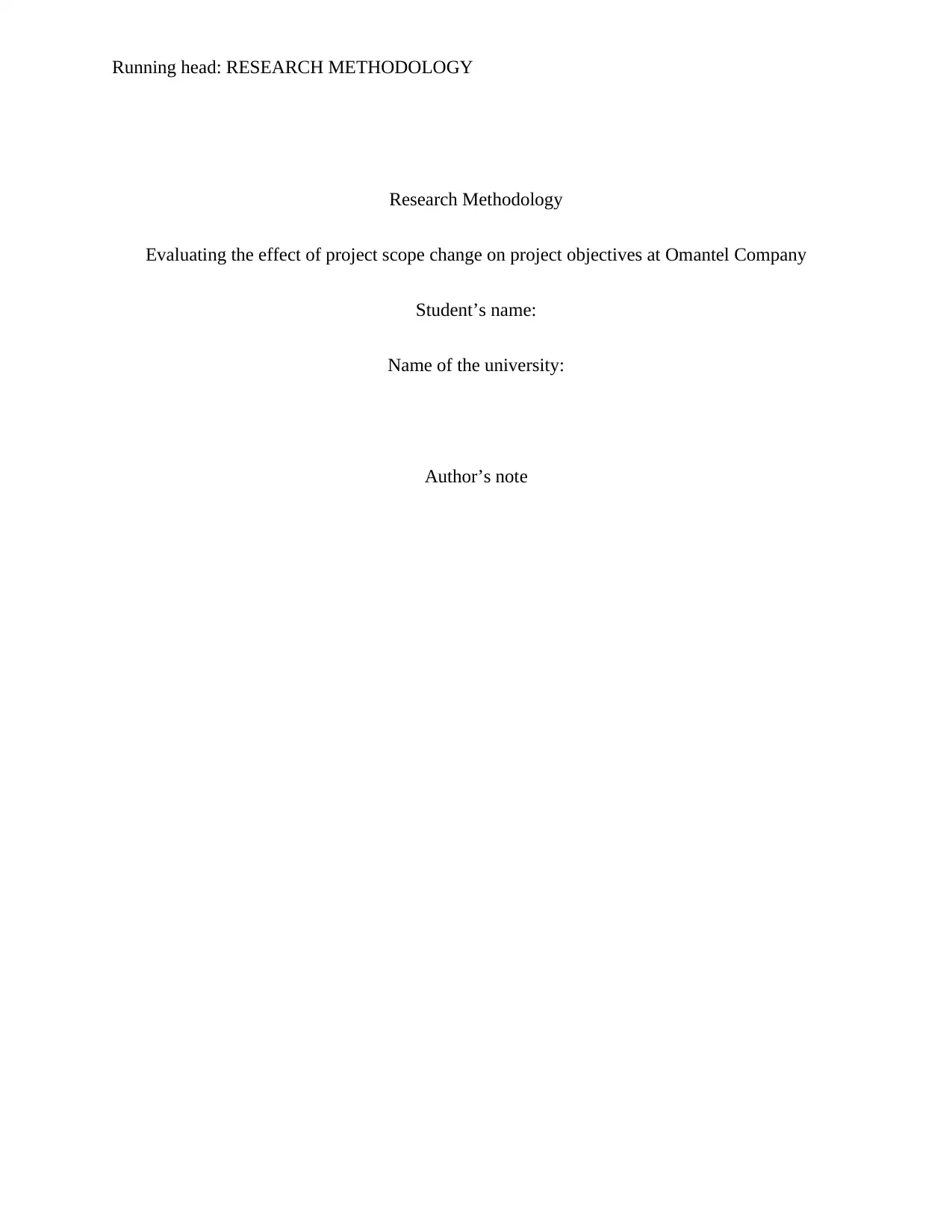
Running head: RESEARCH METHODOLOGY
Research Methodology
Evaluating the effect of project scope change on project objectives at Omantel Company
Student’s name:
Name of the university:
Author’s note
Research Methodology
Evaluating the effect of project scope change on project objectives at Omantel Company
Student’s name:
Name of the university:
Author’s note
Paraphrase This Document
Need a fresh take? Get an instant paraphrase of this document with our AI Paraphraser
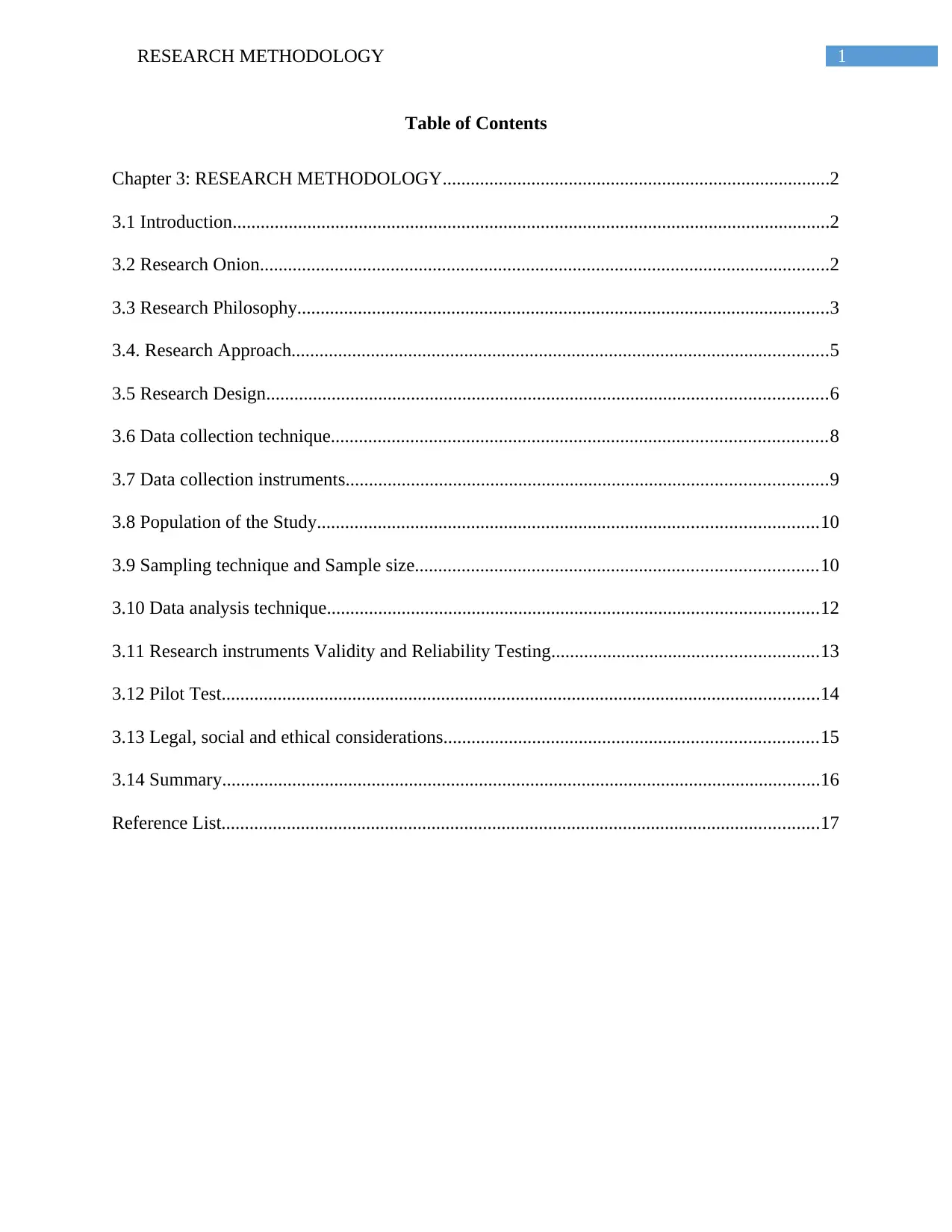
1RESEARCH METHODOLOGY
Table of Contents
Chapter 3: RESEARCH METHODOLOGY...................................................................................2
3.1 Introduction................................................................................................................................2
3.2 Research Onion..........................................................................................................................2
3.3 Research Philosophy..................................................................................................................3
3.4. Research Approach...................................................................................................................5
3.5 Research Design........................................................................................................................6
3.6 Data collection technique..........................................................................................................8
3.7 Data collection instruments.......................................................................................................9
3.8 Population of the Study...........................................................................................................10
3.9 Sampling technique and Sample size......................................................................................10
3.10 Data analysis technique.........................................................................................................12
3.11 Research instruments Validity and Reliability Testing.........................................................13
3.12 Pilot Test................................................................................................................................14
3.13 Legal, social and ethical considerations................................................................................15
3.14 Summary................................................................................................................................16
Reference List................................................................................................................................17
Table of Contents
Chapter 3: RESEARCH METHODOLOGY...................................................................................2
3.1 Introduction................................................................................................................................2
3.2 Research Onion..........................................................................................................................2
3.3 Research Philosophy..................................................................................................................3
3.4. Research Approach...................................................................................................................5
3.5 Research Design........................................................................................................................6
3.6 Data collection technique..........................................................................................................8
3.7 Data collection instruments.......................................................................................................9
3.8 Population of the Study...........................................................................................................10
3.9 Sampling technique and Sample size......................................................................................10
3.10 Data analysis technique.........................................................................................................12
3.11 Research instruments Validity and Reliability Testing.........................................................13
3.12 Pilot Test................................................................................................................................14
3.13 Legal, social and ethical considerations................................................................................15
3.14 Summary................................................................................................................................16
Reference List................................................................................................................................17
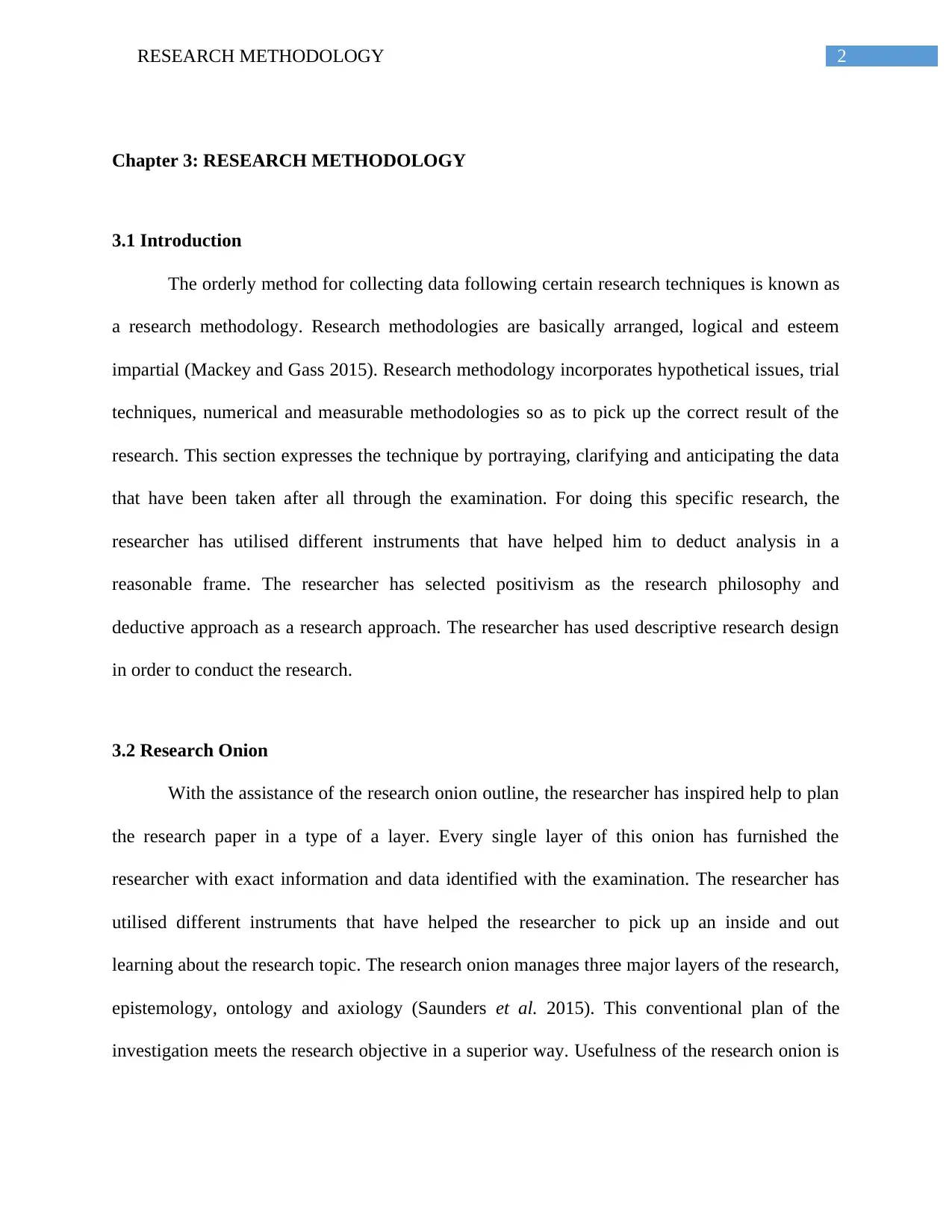
2RESEARCH METHODOLOGY
Chapter 3: RESEARCH METHODOLOGY
3.1 Introduction
The orderly method for collecting data following certain research techniques is known as
a research methodology. Research methodologies are basically arranged, logical and esteem
impartial (Mackey and Gass 2015). Research methodology incorporates hypothetical issues, trial
techniques, numerical and measurable methodologies so as to pick up the correct result of the
research. This section expresses the technique by portraying, clarifying and anticipating the data
that have been taken after all through the examination. For doing this specific research, the
researcher has utilised different instruments that have helped him to deduct analysis in a
reasonable frame. The researcher has selected positivism as the research philosophy and
deductive approach as a research approach. The researcher has used descriptive research design
in order to conduct the research.
3.2 Research Onion
With the assistance of the research onion outline, the researcher has inspired help to plan
the research paper in a type of a layer. Every single layer of this onion has furnished the
researcher with exact information and data identified with the examination. The researcher has
utilised different instruments that have helped the researcher to pick up an inside and out
learning about the research topic. The research onion manages three major layers of the research,
epistemology, ontology and axiology (Saunders et al. 2015). This conventional plan of the
investigation meets the research objective in a superior way. Usefulness of the research onion is
Chapter 3: RESEARCH METHODOLOGY
3.1 Introduction
The orderly method for collecting data following certain research techniques is known as
a research methodology. Research methodologies are basically arranged, logical and esteem
impartial (Mackey and Gass 2015). Research methodology incorporates hypothetical issues, trial
techniques, numerical and measurable methodologies so as to pick up the correct result of the
research. This section expresses the technique by portraying, clarifying and anticipating the data
that have been taken after all through the examination. For doing this specific research, the
researcher has utilised different instruments that have helped him to deduct analysis in a
reasonable frame. The researcher has selected positivism as the research philosophy and
deductive approach as a research approach. The researcher has used descriptive research design
in order to conduct the research.
3.2 Research Onion
With the assistance of the research onion outline, the researcher has inspired help to plan
the research paper in a type of a layer. Every single layer of this onion has furnished the
researcher with exact information and data identified with the examination. The researcher has
utilised different instruments that have helped the researcher to pick up an inside and out
learning about the research topic. The research onion manages three major layers of the research,
epistemology, ontology and axiology (Saunders et al. 2015). This conventional plan of the
investigation meets the research objective in a superior way. Usefulness of the research onion is
⊘ This is a preview!⊘
Do you want full access?
Subscribe today to unlock all pages.

Trusted by 1+ million students worldwide
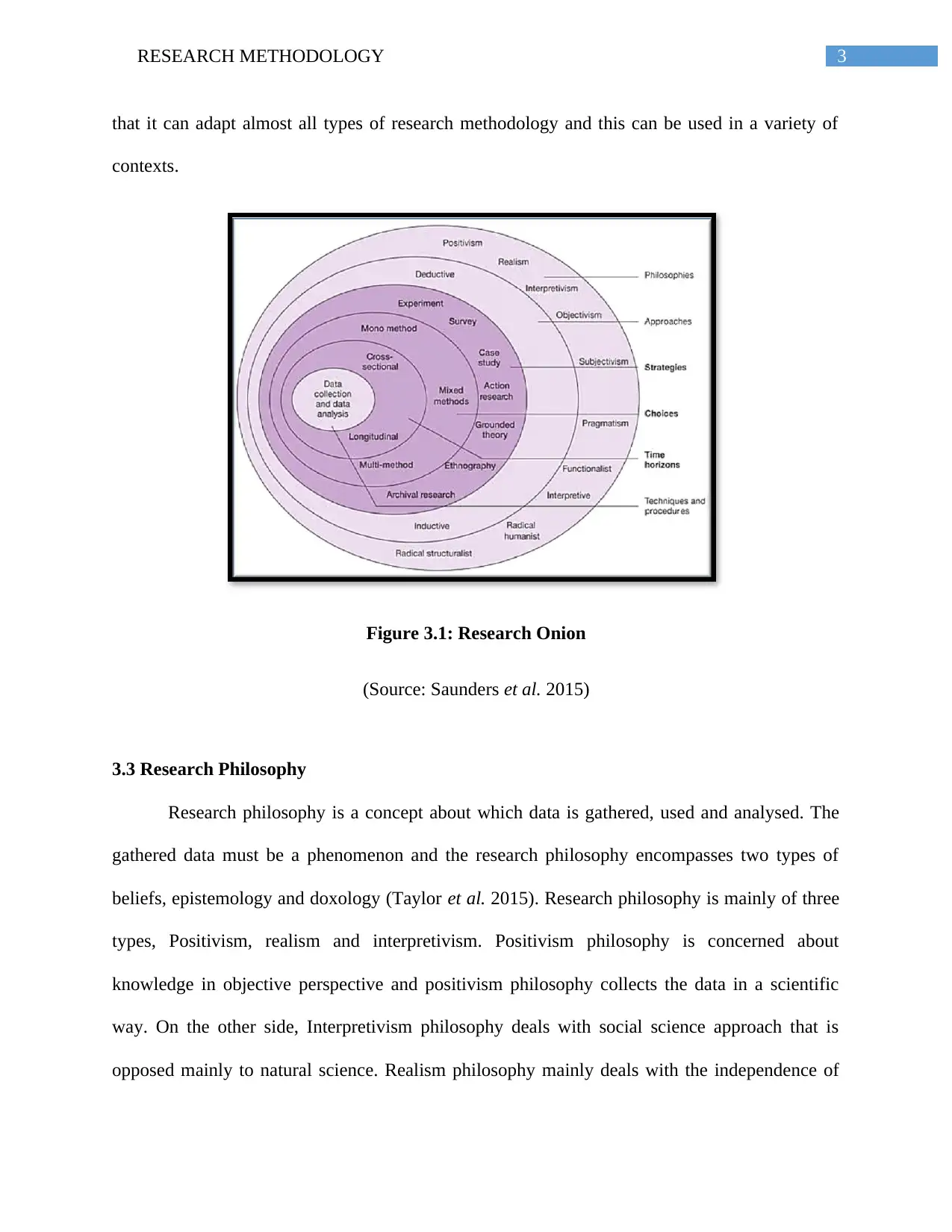
3RESEARCH METHODOLOGY
that it can adapt almost all types of research methodology and this can be used in a variety of
contexts.
Figure 3.1: Research Onion
(Source: Saunders et al. 2015)
3.3 Research Philosophy
Research philosophy is a concept about which data is gathered, used and analysed. The
gathered data must be a phenomenon and the research philosophy encompasses two types of
beliefs, epistemology and doxology (Taylor et al. 2015). Research philosophy is mainly of three
types, Positivism, realism and interpretivism. Positivism philosophy is concerned about
knowledge in objective perspective and positivism philosophy collects the data in a scientific
way. On the other side, Interpretivism philosophy deals with social science approach that is
opposed mainly to natural science. Realism philosophy mainly deals with the independence of
that it can adapt almost all types of research methodology and this can be used in a variety of
contexts.
Figure 3.1: Research Onion
(Source: Saunders et al. 2015)
3.3 Research Philosophy
Research philosophy is a concept about which data is gathered, used and analysed. The
gathered data must be a phenomenon and the research philosophy encompasses two types of
beliefs, epistemology and doxology (Taylor et al. 2015). Research philosophy is mainly of three
types, Positivism, realism and interpretivism. Positivism philosophy is concerned about
knowledge in objective perspective and positivism philosophy collects the data in a scientific
way. On the other side, Interpretivism philosophy deals with social science approach that is
opposed mainly to natural science. Realism philosophy mainly deals with the independence of
Paraphrase This Document
Need a fresh take? Get an instant paraphrase of this document with our AI Paraphraser
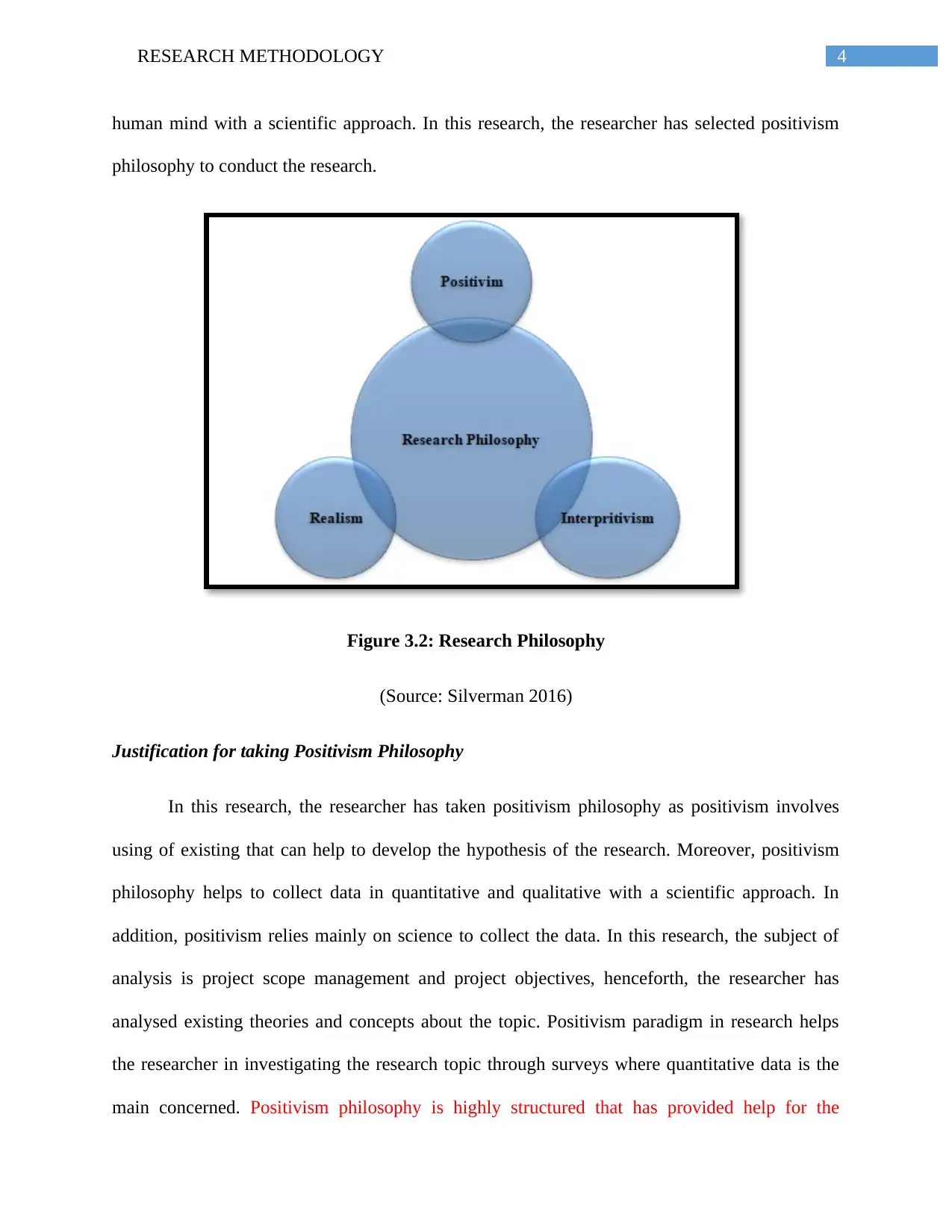
4RESEARCH METHODOLOGY
human mind with a scientific approach. In this research, the researcher has selected positivism
philosophy to conduct the research.
Figure 3.2: Research Philosophy
(Source: Silverman 2016)
Justification for taking Positivism Philosophy
In this research, the researcher has taken positivism philosophy as positivism involves
using of existing that can help to develop the hypothesis of the research. Moreover, positivism
philosophy helps to collect data in quantitative and qualitative with a scientific approach. In
addition, positivism relies mainly on science to collect the data. In this research, the subject of
analysis is project scope management and project objectives, henceforth, the researcher has
analysed existing theories and concepts about the topic. Positivism paradigm in research helps
the researcher in investigating the research topic through surveys where quantitative data is the
main concerned. Positivism philosophy is highly structured that has provided help for the
human mind with a scientific approach. In this research, the researcher has selected positivism
philosophy to conduct the research.
Figure 3.2: Research Philosophy
(Source: Silverman 2016)
Justification for taking Positivism Philosophy
In this research, the researcher has taken positivism philosophy as positivism involves
using of existing that can help to develop the hypothesis of the research. Moreover, positivism
philosophy helps to collect data in quantitative and qualitative with a scientific approach. In
addition, positivism relies mainly on science to collect the data. In this research, the subject of
analysis is project scope management and project objectives, henceforth, the researcher has
analysed existing theories and concepts about the topic. Positivism paradigm in research helps
the researcher in investigating the research topic through surveys where quantitative data is the
main concerned. Positivism philosophy is highly structured that has provided help for the
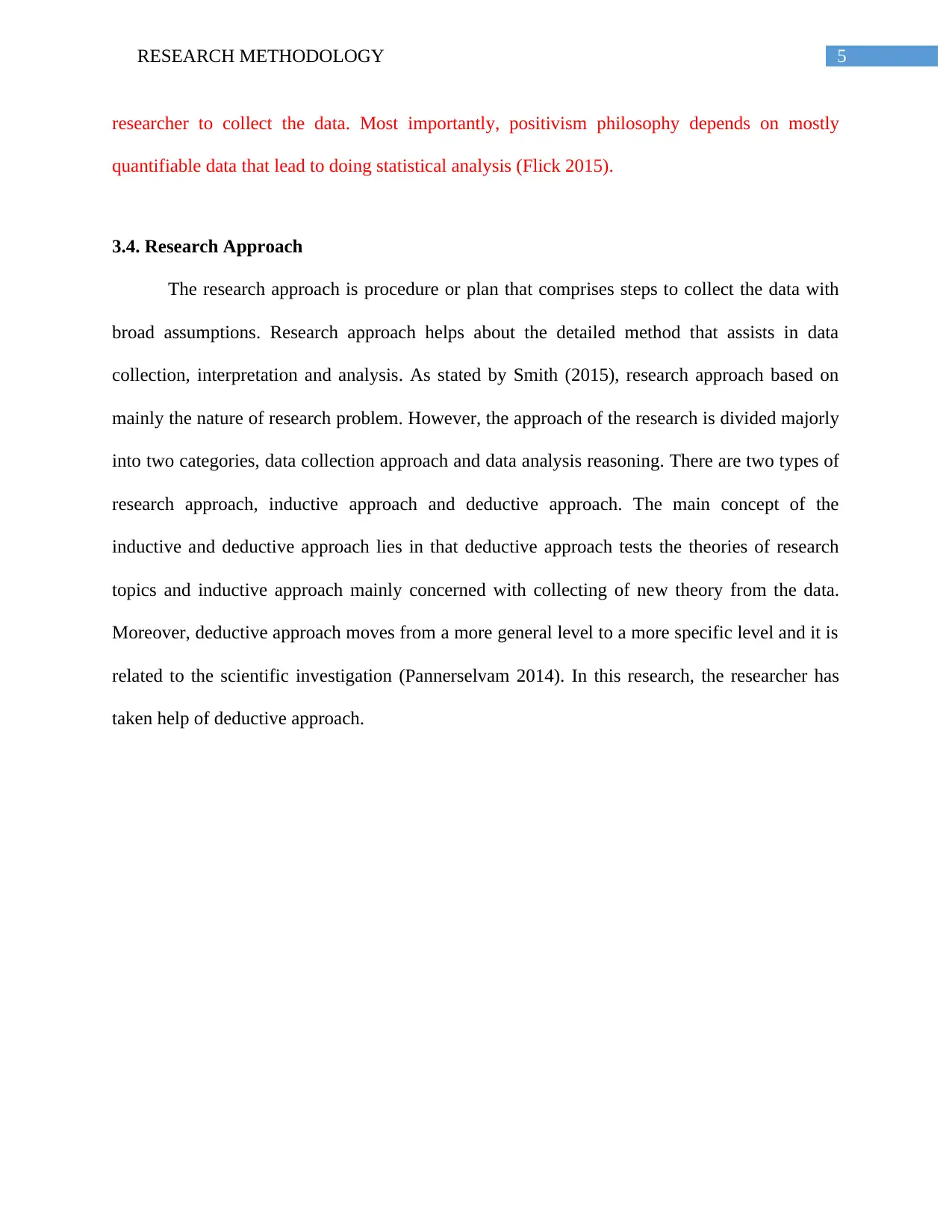
5RESEARCH METHODOLOGY
researcher to collect the data. Most importantly, positivism philosophy depends on mostly
quantifiable data that lead to doing statistical analysis (Flick 2015).
3.4. Research Approach
The research approach is procedure or plan that comprises steps to collect the data with
broad assumptions. Research approach helps about the detailed method that assists in data
collection, interpretation and analysis. As stated by Smith (2015), research approach based on
mainly the nature of research problem. However, the approach of the research is divided majorly
into two categories, data collection approach and data analysis reasoning. There are two types of
research approach, inductive approach and deductive approach. The main concept of the
inductive and deductive approach lies in that deductive approach tests the theories of research
topics and inductive approach mainly concerned with collecting of new theory from the data.
Moreover, deductive approach moves from a more general level to a more specific level and it is
related to the scientific investigation (Pannerselvam 2014). In this research, the researcher has
taken help of deductive approach.
researcher to collect the data. Most importantly, positivism philosophy depends on mostly
quantifiable data that lead to doing statistical analysis (Flick 2015).
3.4. Research Approach
The research approach is procedure or plan that comprises steps to collect the data with
broad assumptions. Research approach helps about the detailed method that assists in data
collection, interpretation and analysis. As stated by Smith (2015), research approach based on
mainly the nature of research problem. However, the approach of the research is divided majorly
into two categories, data collection approach and data analysis reasoning. There are two types of
research approach, inductive approach and deductive approach. The main concept of the
inductive and deductive approach lies in that deductive approach tests the theories of research
topics and inductive approach mainly concerned with collecting of new theory from the data.
Moreover, deductive approach moves from a more general level to a more specific level and it is
related to the scientific investigation (Pannerselvam 2014). In this research, the researcher has
taken help of deductive approach.
⊘ This is a preview!⊘
Do you want full access?
Subscribe today to unlock all pages.

Trusted by 1+ million students worldwide
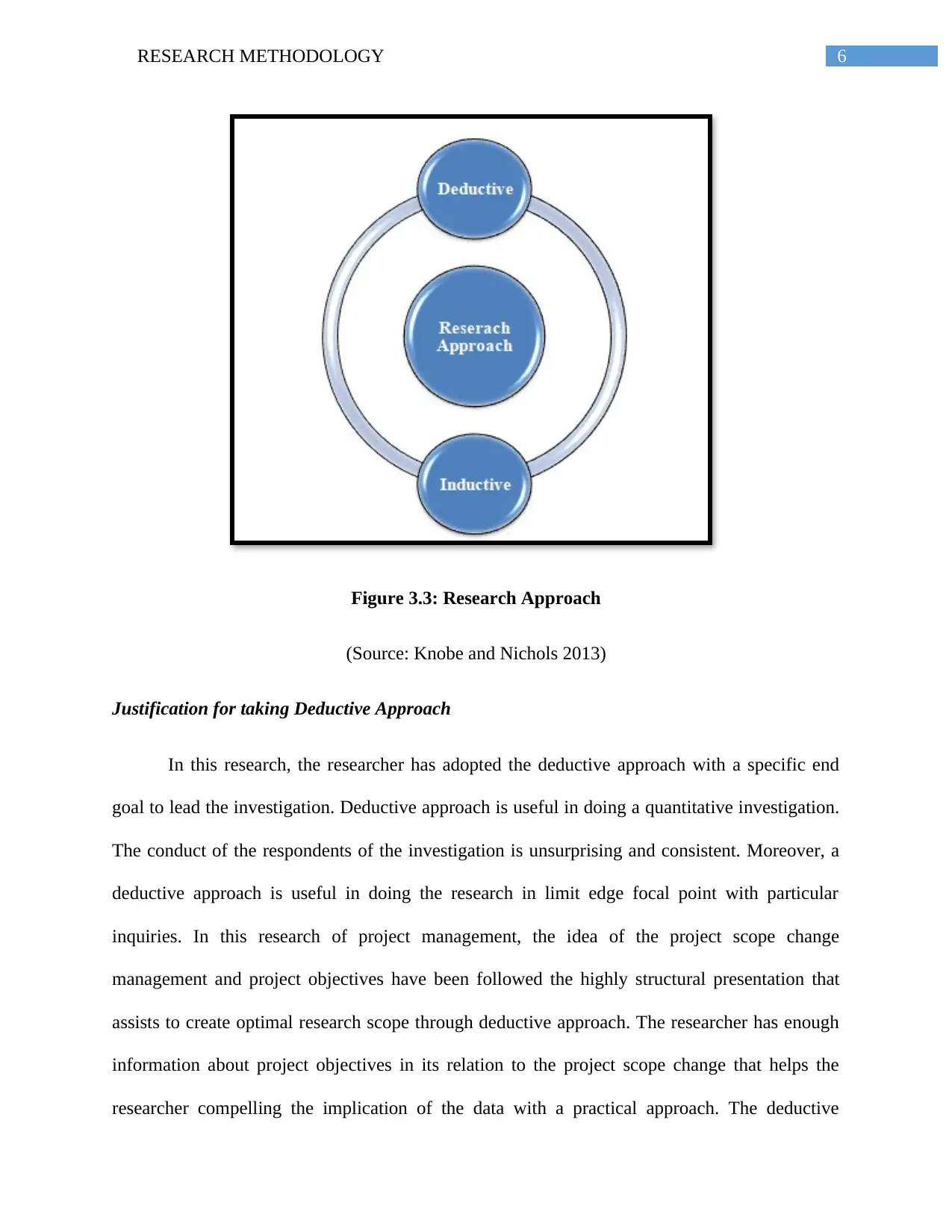
6RESEARCH METHODOLOGY
Figure 3.3: Research Approach
(Source: Knobe and Nichols 2013)
Justification for taking Deductive Approach
In this research, the researcher has adopted the deductive approach with a specific end
goal to lead the investigation. Deductive approach is useful in doing a quantitative investigation.
The conduct of the respondents of the investigation is unsurprising and consistent. Moreover, a
deductive approach is useful in doing the research in limit edge focal point with particular
inquiries. In this research of project management, the idea of the project scope change
management and project objectives have been followed the highly structural presentation that
assists to create optimal research scope through deductive approach. The researcher has enough
information about project objectives in its relation to the project scope change that helps the
researcher compelling the implication of the data with a practical approach. The deductive
Figure 3.3: Research Approach
(Source: Knobe and Nichols 2013)
Justification for taking Deductive Approach
In this research, the researcher has adopted the deductive approach with a specific end
goal to lead the investigation. Deductive approach is useful in doing a quantitative investigation.
The conduct of the respondents of the investigation is unsurprising and consistent. Moreover, a
deductive approach is useful in doing the research in limit edge focal point with particular
inquiries. In this research of project management, the idea of the project scope change
management and project objectives have been followed the highly structural presentation that
assists to create optimal research scope through deductive approach. The researcher has enough
information about project objectives in its relation to the project scope change that helps the
researcher compelling the implication of the data with a practical approach. The deductive
Paraphrase This Document
Need a fresh take? Get an instant paraphrase of this document with our AI Paraphraser
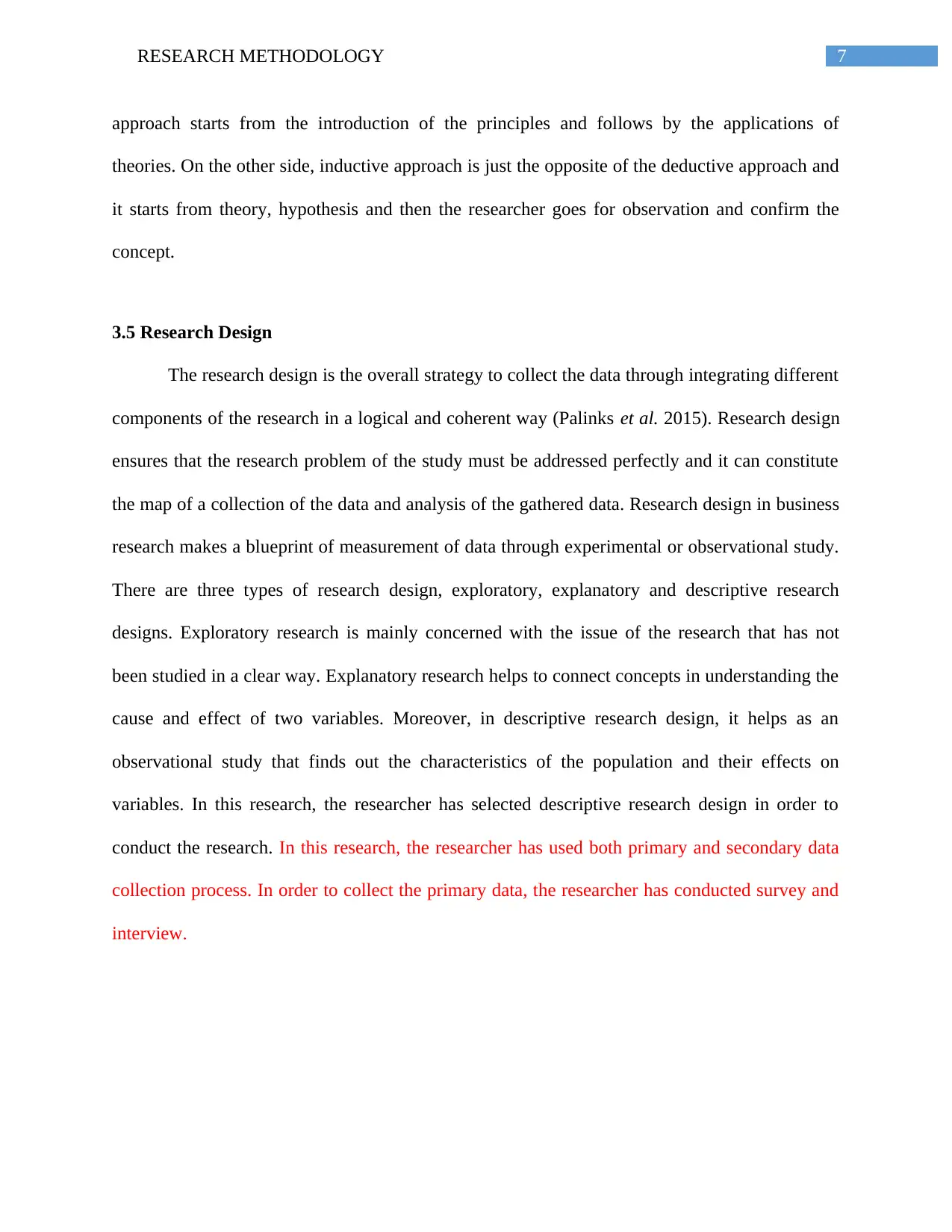
7RESEARCH METHODOLOGY
approach starts from the introduction of the principles and follows by the applications of
theories. On the other side, inductive approach is just the opposite of the deductive approach and
it starts from theory, hypothesis and then the researcher goes for observation and confirm the
concept.
3.5 Research Design
The research design is the overall strategy to collect the data through integrating different
components of the research in a logical and coherent way (Palinks et al. 2015). Research design
ensures that the research problem of the study must be addressed perfectly and it can constitute
the map of a collection of the data and analysis of the gathered data. Research design in business
research makes a blueprint of measurement of data through experimental or observational study.
There are three types of research design, exploratory, explanatory and descriptive research
designs. Exploratory research is mainly concerned with the issue of the research that has not
been studied in a clear way. Explanatory research helps to connect concepts in understanding the
cause and effect of two variables. Moreover, in descriptive research design, it helps as an
observational study that finds out the characteristics of the population and their effects on
variables. In this research, the researcher has selected descriptive research design in order to
conduct the research. In this research, the researcher has used both primary and secondary data
collection process. In order to collect the primary data, the researcher has conducted survey and
interview.
approach starts from the introduction of the principles and follows by the applications of
theories. On the other side, inductive approach is just the opposite of the deductive approach and
it starts from theory, hypothesis and then the researcher goes for observation and confirm the
concept.
3.5 Research Design
The research design is the overall strategy to collect the data through integrating different
components of the research in a logical and coherent way (Palinks et al. 2015). Research design
ensures that the research problem of the study must be addressed perfectly and it can constitute
the map of a collection of the data and analysis of the gathered data. Research design in business
research makes a blueprint of measurement of data through experimental or observational study.
There are three types of research design, exploratory, explanatory and descriptive research
designs. Exploratory research is mainly concerned with the issue of the research that has not
been studied in a clear way. Explanatory research helps to connect concepts in understanding the
cause and effect of two variables. Moreover, in descriptive research design, it helps as an
observational study that finds out the characteristics of the population and their effects on
variables. In this research, the researcher has selected descriptive research design in order to
conduct the research. In this research, the researcher has used both primary and secondary data
collection process. In order to collect the primary data, the researcher has conducted survey and
interview.
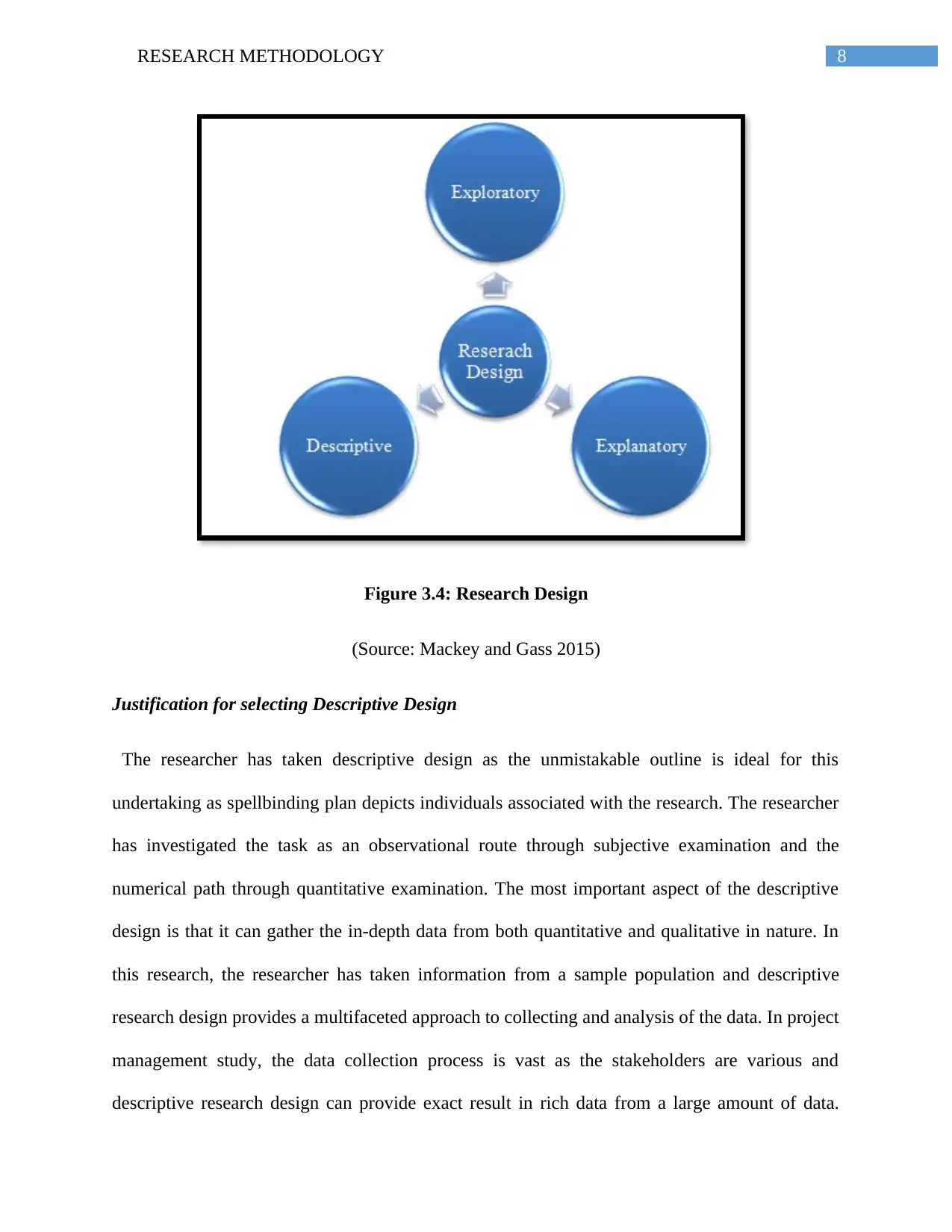
8RESEARCH METHODOLOGY
Figure 3.4: Research Design
(Source: Mackey and Gass 2015)
Justification for selecting Descriptive Design
The researcher has taken descriptive design as the unmistakable outline is ideal for this
undertaking as spellbinding plan depicts individuals associated with the research. The researcher
has investigated the task as an observational route through subjective examination and the
numerical path through quantitative examination. The most important aspect of the descriptive
design is that it can gather the in-depth data from both quantitative and qualitative in nature. In
this research, the researcher has taken information from a sample population and descriptive
research design provides a multifaceted approach to collecting and analysis of the data. In project
management study, the data collection process is vast as the stakeholders are various and
descriptive research design can provide exact result in rich data from a large amount of data.
Figure 3.4: Research Design
(Source: Mackey and Gass 2015)
Justification for selecting Descriptive Design
The researcher has taken descriptive design as the unmistakable outline is ideal for this
undertaking as spellbinding plan depicts individuals associated with the research. The researcher
has investigated the task as an observational route through subjective examination and the
numerical path through quantitative examination. The most important aspect of the descriptive
design is that it can gather the in-depth data from both quantitative and qualitative in nature. In
this research, the researcher has taken information from a sample population and descriptive
research design provides a multifaceted approach to collecting and analysis of the data. In project
management study, the data collection process is vast as the stakeholders are various and
descriptive research design can provide exact result in rich data from a large amount of data.
⊘ This is a preview!⊘
Do you want full access?
Subscribe today to unlock all pages.

Trusted by 1+ million students worldwide
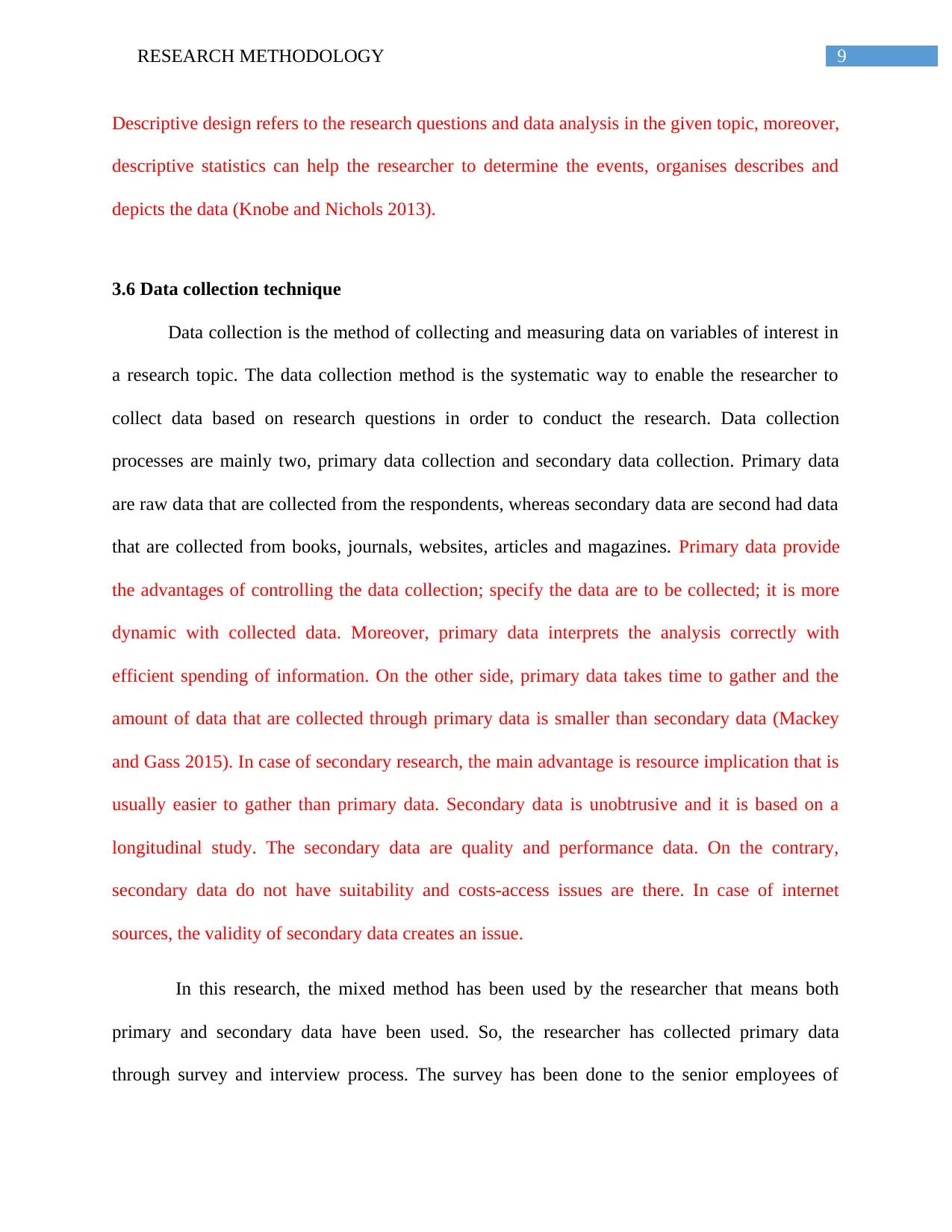
9RESEARCH METHODOLOGY
Descriptive design refers to the research questions and data analysis in the given topic, moreover,
descriptive statistics can help the researcher to determine the events, organises describes and
depicts the data (Knobe and Nichols 2013).
3.6 Data collection technique
Data collection is the method of collecting and measuring data on variables of interest in
a research topic. The data collection method is the systematic way to enable the researcher to
collect data based on research questions in order to conduct the research. Data collection
processes are mainly two, primary data collection and secondary data collection. Primary data
are raw data that are collected from the respondents, whereas secondary data are second had data
that are collected from books, journals, websites, articles and magazines. Primary data provide
the advantages of controlling the data collection; specify the data are to be collected; it is more
dynamic with collected data. Moreover, primary data interprets the analysis correctly with
efficient spending of information. On the other side, primary data takes time to gather and the
amount of data that are collected through primary data is smaller than secondary data (Mackey
and Gass 2015). In case of secondary research, the main advantage is resource implication that is
usually easier to gather than primary data. Secondary data is unobtrusive and it is based on a
longitudinal study. The secondary data are quality and performance data. On the contrary,
secondary data do not have suitability and costs-access issues are there. In case of internet
sources, the validity of secondary data creates an issue.
In this research, the mixed method has been used by the researcher that means both
primary and secondary data have been used. So, the researcher has collected primary data
through survey and interview process. The survey has been done to the senior employees of
Descriptive design refers to the research questions and data analysis in the given topic, moreover,
descriptive statistics can help the researcher to determine the events, organises describes and
depicts the data (Knobe and Nichols 2013).
3.6 Data collection technique
Data collection is the method of collecting and measuring data on variables of interest in
a research topic. The data collection method is the systematic way to enable the researcher to
collect data based on research questions in order to conduct the research. Data collection
processes are mainly two, primary data collection and secondary data collection. Primary data
are raw data that are collected from the respondents, whereas secondary data are second had data
that are collected from books, journals, websites, articles and magazines. Primary data provide
the advantages of controlling the data collection; specify the data are to be collected; it is more
dynamic with collected data. Moreover, primary data interprets the analysis correctly with
efficient spending of information. On the other side, primary data takes time to gather and the
amount of data that are collected through primary data is smaller than secondary data (Mackey
and Gass 2015). In case of secondary research, the main advantage is resource implication that is
usually easier to gather than primary data. Secondary data is unobtrusive and it is based on a
longitudinal study. The secondary data are quality and performance data. On the contrary,
secondary data do not have suitability and costs-access issues are there. In case of internet
sources, the validity of secondary data creates an issue.
In this research, the mixed method has been used by the researcher that means both
primary and secondary data have been used. So, the researcher has collected primary data
through survey and interview process. The survey has been done to the senior employees of
Paraphrase This Document
Need a fresh take? Get an instant paraphrase of this document with our AI Paraphraser
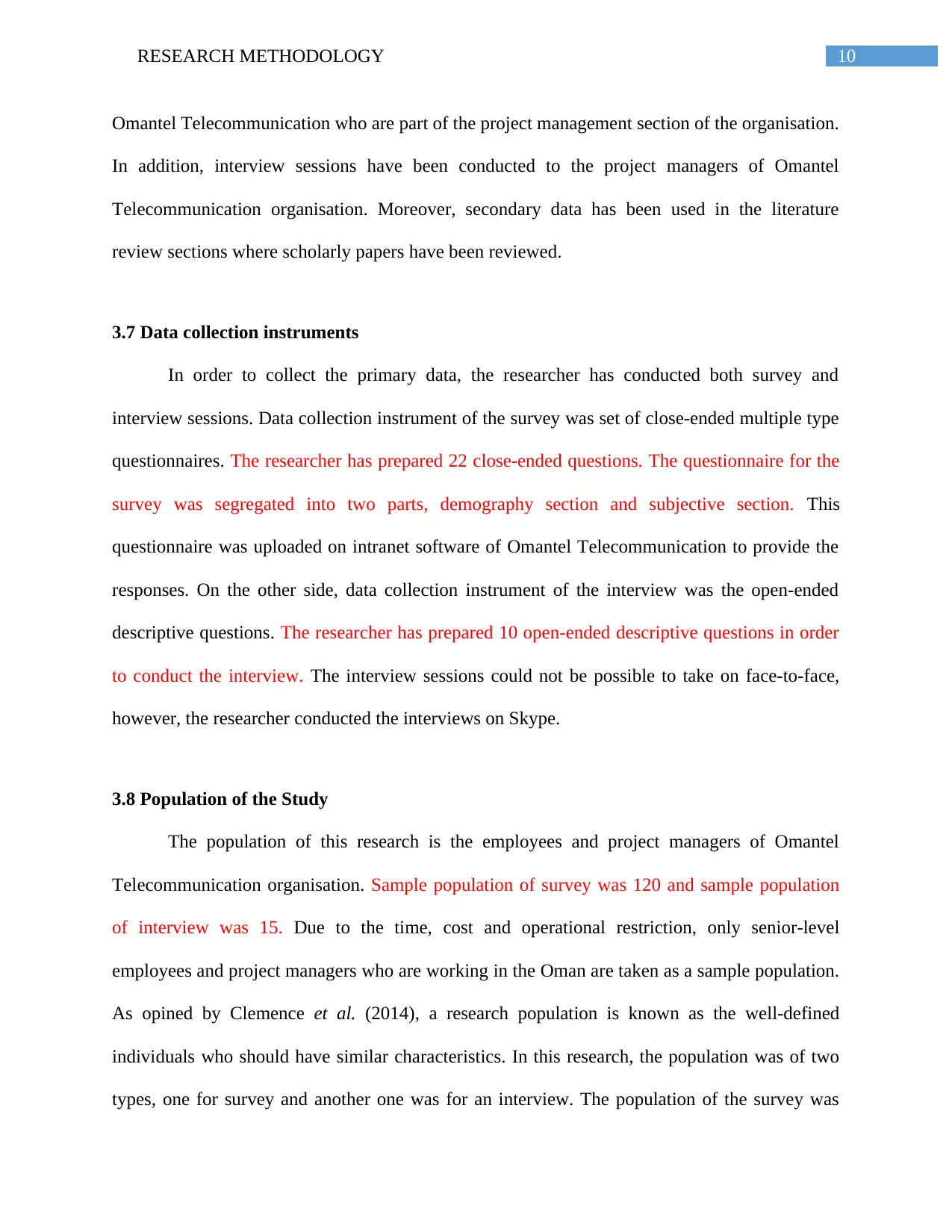
10RESEARCH METHODOLOGY
Omantel Telecommunication who are part of the project management section of the organisation.
In addition, interview sessions have been conducted to the project managers of Omantel
Telecommunication organisation. Moreover, secondary data has been used in the literature
review sections where scholarly papers have been reviewed.
3.7 Data collection instruments
In order to collect the primary data, the researcher has conducted both survey and
interview sessions. Data collection instrument of the survey was set of close-ended multiple type
questionnaires. The researcher has prepared 22 close-ended questions. The questionnaire for the
survey was segregated into two parts, demography section and subjective section. This
questionnaire was uploaded on intranet software of Omantel Telecommunication to provide the
responses. On the other side, data collection instrument of the interview was the open-ended
descriptive questions. The researcher has prepared 10 open-ended descriptive questions in order
to conduct the interview. The interview sessions could not be possible to take on face-to-face,
however, the researcher conducted the interviews on Skype.
3.8 Population of the Study
The population of this research is the employees and project managers of Omantel
Telecommunication organisation. Sample population of survey was 120 and sample population
of interview was 15. Due to the time, cost and operational restriction, only senior-level
employees and project managers who are working in the Oman are taken as a sample population.
As opined by Clemence et al. (2014), a research population is known as the well-defined
individuals who should have similar characteristics. In this research, the population was of two
types, one for survey and another one was for an interview. The population of the survey was
Omantel Telecommunication who are part of the project management section of the organisation.
In addition, interview sessions have been conducted to the project managers of Omantel
Telecommunication organisation. Moreover, secondary data has been used in the literature
review sections where scholarly papers have been reviewed.
3.7 Data collection instruments
In order to collect the primary data, the researcher has conducted both survey and
interview sessions. Data collection instrument of the survey was set of close-ended multiple type
questionnaires. The researcher has prepared 22 close-ended questions. The questionnaire for the
survey was segregated into two parts, demography section and subjective section. This
questionnaire was uploaded on intranet software of Omantel Telecommunication to provide the
responses. On the other side, data collection instrument of the interview was the open-ended
descriptive questions. The researcher has prepared 10 open-ended descriptive questions in order
to conduct the interview. The interview sessions could not be possible to take on face-to-face,
however, the researcher conducted the interviews on Skype.
3.8 Population of the Study
The population of this research is the employees and project managers of Omantel
Telecommunication organisation. Sample population of survey was 120 and sample population
of interview was 15. Due to the time, cost and operational restriction, only senior-level
employees and project managers who are working in the Oman are taken as a sample population.
As opined by Clemence et al. (2014), a research population is known as the well-defined
individuals who should have similar characteristics. In this research, the population was of two
types, one for survey and another one was for an interview. The population of the survey was
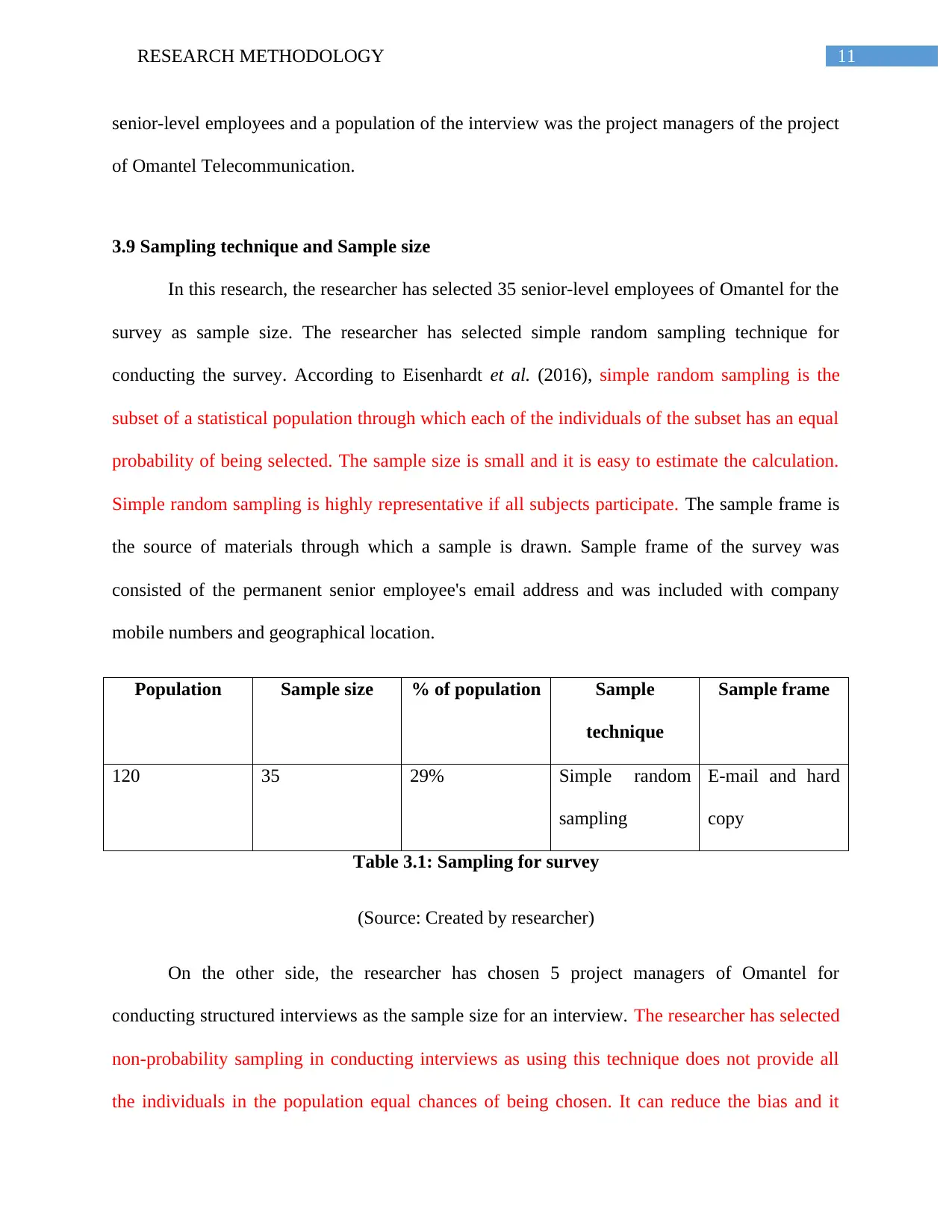
11RESEARCH METHODOLOGY
senior-level employees and a population of the interview was the project managers of the project
of Omantel Telecommunication.
3.9 Sampling technique and Sample size
In this research, the researcher has selected 35 senior-level employees of Omantel for the
survey as sample size. The researcher has selected simple random sampling technique for
conducting the survey. According to Eisenhardt et al. (2016), simple random sampling is the
subset of a statistical population through which each of the individuals of the subset has an equal
probability of being selected. The sample size is small and it is easy to estimate the calculation.
Simple random sampling is highly representative if all subjects participate. The sample frame is
the source of materials through which a sample is drawn. Sample frame of the survey was
consisted of the permanent senior employee's email address and was included with company
mobile numbers and geographical location.
Population Sample size % of population Sample
technique
Sample frame
120 35 29% Simple random
sampling
E-mail and hard
copy
Table 3.1: Sampling for survey
(Source: Created by researcher)
On the other side, the researcher has chosen 5 project managers of Omantel for
conducting structured interviews as the sample size for an interview. The researcher has selected
non-probability sampling in conducting interviews as using this technique does not provide all
the individuals in the population equal chances of being chosen. It can reduce the bias and it
senior-level employees and a population of the interview was the project managers of the project
of Omantel Telecommunication.
3.9 Sampling technique and Sample size
In this research, the researcher has selected 35 senior-level employees of Omantel for the
survey as sample size. The researcher has selected simple random sampling technique for
conducting the survey. According to Eisenhardt et al. (2016), simple random sampling is the
subset of a statistical population through which each of the individuals of the subset has an equal
probability of being selected. The sample size is small and it is easy to estimate the calculation.
Simple random sampling is highly representative if all subjects participate. The sample frame is
the source of materials through which a sample is drawn. Sample frame of the survey was
consisted of the permanent senior employee's email address and was included with company
mobile numbers and geographical location.
Population Sample size % of population Sample
technique
Sample frame
120 35 29% Simple random
sampling
E-mail and hard
copy
Table 3.1: Sampling for survey
(Source: Created by researcher)
On the other side, the researcher has chosen 5 project managers of Omantel for
conducting structured interviews as the sample size for an interview. The researcher has selected
non-probability sampling in conducting interviews as using this technique does not provide all
the individuals in the population equal chances of being chosen. It can reduce the bias and it
⊘ This is a preview!⊘
Do you want full access?
Subscribe today to unlock all pages.

Trusted by 1+ million students worldwide
1 out of 20
Related Documents
Your All-in-One AI-Powered Toolkit for Academic Success.
+13062052269
info@desklib.com
Available 24*7 on WhatsApp / Email
![[object Object]](/_next/static/media/star-bottom.7253800d.svg)
Unlock your academic potential
Copyright © 2020–2025 A2Z Services. All Rights Reserved. Developed and managed by ZUCOL.





